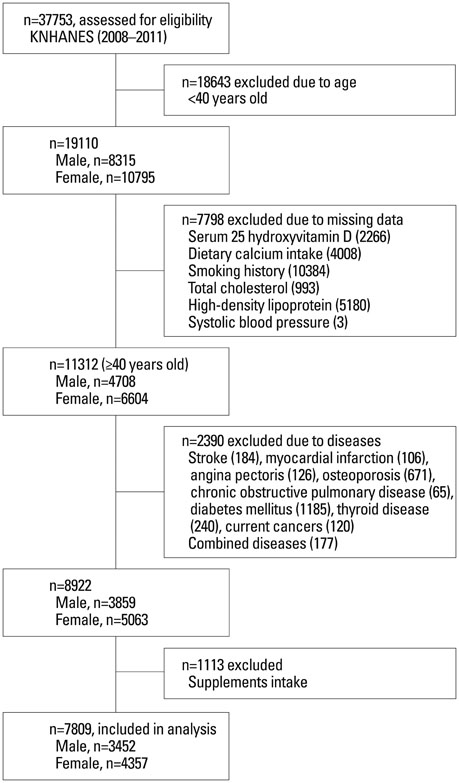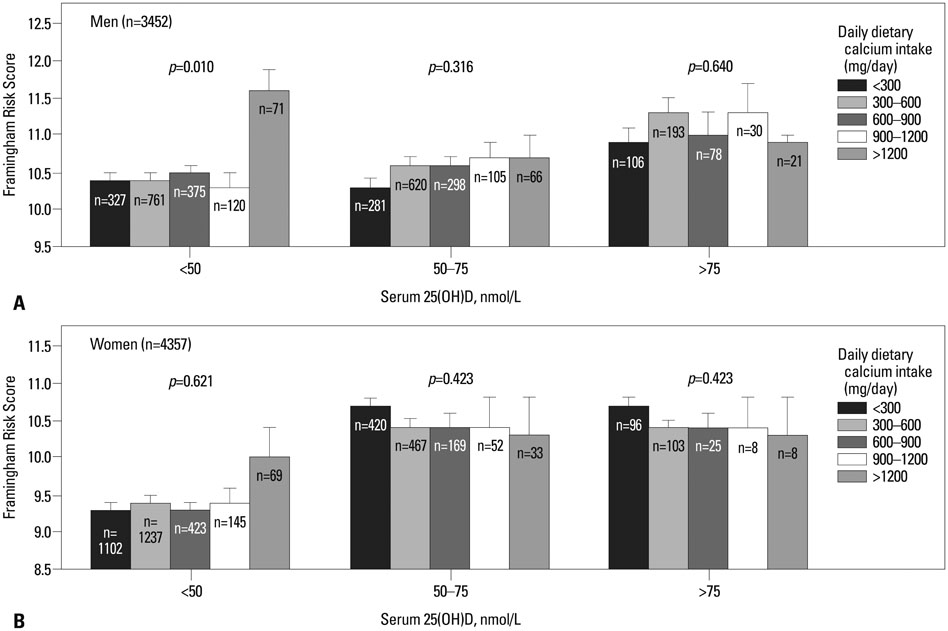Yonsei Med J.
2015 May;56(3):845-852. 10.3349/ymj.2015.56.3.845.
Dietary Calcium and Framingham Risk Score in Vitamin D Deficient Male (KNHANES 2009-2011)
- Affiliations
-
- 1Department of Family Practice and Community Health, Ajou University School of Medicine, Suwon, Korea. jchcmc@hanmail.net
- 2College of Biomedical and Health Sciences, Konkuk University, Chungju, Korea.
- 3CHA Anti-aging Institute, CHA University, Seoul, Korea.
- KMID: 2450363
- DOI: http://doi.org/10.3349/ymj.2015.56.3.845
Abstract
- PURPOSE
The association between excess calcium intake and cardiovascular mortality has already been reported. In the present study, we investigated the relation between dietary calcium intake and Framingham Risk Score (FRS) according to serum 25-hydroxyvitamin D [25(OH)D] status.
MATERIALS AND METHODS
A total of 7809 subjects (3452 males and 4357 female) aged over 40 years were selected for this cross-sectional study from data obtained from the Korea National Health and Nutrition Examination Survey (2008-2011). Daily dietary calcium intake was categorized into <300, 300-600, 600-900, 900-1200, and >1200 mg/day and serum 25(OH)D concentration classified into <50, 50-75, >75 mmol/L. The FRS was compared by the daily dietary calcium intake categories according to 25(OH)D concentration after adjustment with relevant variables in both genders.
RESULTS
Higher FRS was observed in males with both <300 mg and >1200 mg of dietary calcium intake and females with <300 mg of dietary calcium intake without adjustment. The significantly higher FRS remained in the <300 mg and >1200 mg of dietary calcium intake groups in both genders after adjustments for relevant variables. FRS was significantly higher in the group with >1200 mg of dietary calcium intake and serum 25(OH)D <50 nmol/L, which was the male only vitamin D deficient group.
CONCLUSION
Very low (<300 mg/day) and excess (>1200 mg/day) dietary calcium intake were related with higher FRS in both genders. In particular, higher FRS was observed in the excess (>1200 mg/day) dietary calcium intake male group under vitamin D deficiency (<50 nmol/L).
Keyword
MeSH Terms
Figure
Reference
-
1. Grandi NC, Brenner H, Hahmann H, Wüsten B, März W, Rothenbacher D, et al. Calcium, phosphate and the risk of cardiovascular events and all-cause mortality in a population with stable coronary heart disease. Heart. 2012; 98:926–933.
Article2. Leifsson BG, Ahrén B. Serum calcium and survival in a large health screening program. J Clin Endocrinol Metab. 1996; 81:2149–2153.
Article3. Lundgren E, Lind L, Palmér M, Jakobsson S, Ljunghall S, Rastad J. Increased cardiovascular mortality and normalized serum calcium in patients with mild hypercalcemia followed up for 25 years. Surgery. 2001; 130:978–985.
Article4. Marco MP, Craver L, Betriu A, Belart M, Fibla J, Fernández E. Higher impact of mineral metabolism on cardiovascular mortality in a European hemodialysis population. Kidney Int Suppl. 2003; S111–S114.
Article5. Ogard CG, Petersen J, Jørgensen T, Almdal T, Vestergaard H. Serum ionised calcium and cardiovascular disease in 45-years old men and women followed for 18 years. Eur J Epidemiol. 2006; 21:123–127.
Article6. Palmer SC, Hayen A, Macaskill P, Pellegrini F, Craig JC, Elder GJ, et al. Serum levels of phosphorus, parathyroid hormone, and calcium and risks of death and cardiovascular disease in individuals with chronic kidney disease: a systematic review and meta-analysis. JAMA. 2011; 305:1119–1127.
Article7. Xiao Q, Murphy RA, Houston DK, Harris TB, Chow WH, Park Y. Dietary and supplemental calcium intake and cardiovascular disease mortality: the National Institutes of Health-AARP diet and health study. JAMA Intern Med. 2013; 173:639–646.
Article8. Reunanen A, Knekt P, Marniemi J, Mäki J, Maatela J, Aromaa A. Serum calcium, magnesium, copper and zinc and risk of cardiovascular death. Eur J Clin Nutr. 1996; 50:431–437.9. Bailey RL, Dodd KW, Goldman JA, Gahche JJ, Dwyer JT, Moshfegh AJ, et al. Estimation of total usual calcium and vitamin D intakes in the United States. J Nutr. 2010; 140:817–822.
Article10. Hennekens CH, Barice EJ. Calcium supplements and risk of myocardial infarction: a hypothesis formulated but not yet adequately tested. Am J Med. 2011; 124:1097–1098.
Article11. Reid IR, Bolland MJ, Grey A. Calcium supplements and risk of myocardial infarction: an hypothesis twice tested. Am J Med. 2012; 125:e15.
Article12. Kaluza J, Orsini N, Levitan EB, Brzozowska A, Roszkowski W, Wolk A. Dietary calcium and magnesium intake and mortality: a prospective study of men. Am J Epidemiol. 2010; 171:801–807.
Article13. Bucher HC, Cook RJ, Guyatt GH, Lang JD, Cook DJ, Hatala R, et al. Effects of dietary calcium supplementation on blood pressure. A meta-analysis of randomized controlled trials. JAMA. 1996; 275:1016–1022.
Article14. Cappuccio FP, Elliott P, Allender PS, Pryer J, Follman DA, Cutler JA. Epidemiologic association between dietary calcium intake and blood pressure: a meta-analysis of published data. Am J Epidemiol. 1995; 142:935–945.
Article15. Reid IR, Mason B, Horne A, Ames R, Clearwater J, Bava U, et al. Effects of calcium supplementation on serum lipid concentrations in normal older women: a randomized controlled trial. Am J Med. 2002; 112:343–347.
Article16. Zhu B, Haruyama Y, Muto T, Yamasaki A, Tarumi F. Evaluation of a community intervention program in Japan using Framingham risk score and estimated 10-year coronary heart disease risk as outcome variables: a non-randomized controlled trial. BMC Public Health. 2013; 13:219.
Article17. Joo NS, Dawson-Hughes B, Kim YS, Oh K, Yeum KJ. Impact of calcium and vitamin D insufficiencies on serum parathyroid hormone and bone mineral density: analysis of the fourth and fifth Korea National Health and Nutrition Examination Survey (KNHANES IV-3, 2009 and KNHANES V-1, 2010). J Bone Miner Res. 2013; 28:764–770.
Article18. Joo NS, Dawson-Hughes B, Yeum KJ. 25-Hydroxyvitamin D, calcium intake, and bone mineral content in adolescents and young adults: analysis of the fourth and fifth Korea National Health and Nutrition Examination Survey (KNHANES IV-2, 3, 2008-2009 and V-1, 2010). J Clin Endocrinol Metab. 2013; 98:3627–3636.
Article19. Food composition table. 7th ed. Suwon, Korea: National Rural Resource Development Institute;2006.20. Wilson PW, D'Agostino RB, Levy D, Belanger AM, Silbershatz H, Kannel WB. Prediction of coronary heart disease using risk factor categories. Circulation. 1998; 97:1837–1847.
Article21. Samelson EJ, Booth SL, Fox CS, Tucker KL, Wang TJ, Hoffmann U, et al. Calcium intake is not associated with increased coronary artery calcification: the Framingham Study. Am J Clin Nutr. 2012; 96:1274–1280.
Article22. Van der Vijver LP, van der Waal MA, Weterings KG, Dekker JM, Schouten EG, Kok FJ. Calcium intake and 28-year cardiovascular and coronary heart disease mortality in Dutch civil servants. Int J Epidemiol. 1992; 21:36–39.
Article23. Ascherio A, Rimm EB, Hernán MA, Giovannucci EL, Kawachi I, Stampfer MJ, et al. Intake of potassium, magnesium, calcium, and fiber and risk of stroke among US men. Circulation. 1998; 98:1198–1204.
Article24. Umesawa M, Iso H, Date C, Yamamoto A, Toyoshima H, Watanabe Y, et al. Dietary intake of calcium in relation to mortality from cardiovascular disease: the JACC Study. Stroke. 2006; 37:20–26.
Article25. Michaëlsson K, Melhus H, Warensjö Lemming E, Wolk A, Byberg L. Long term calcium intake and rates of all cause and cardiovascular mortality: community based prospective longitudinal cohort study. BMJ. 2013; 346:f228.
Article26. Zemel MB. Regulation of adiposity and obesity risk by dietary calcium: mechanisms and implications. J Am Coll Nutr. 2002; 21:146S–151S.
Article27. Goodman WG, Goldin J, Kuizon BD, Yoon C, Gales B, Sider D, et al. Coronary-artery calcification in young adults with end-stage renal disease who are undergoing dialysis. N Engl J Med. 2000; 342:1478–1483.
Article28. Slinin Y, Blackwell T, Ishani A, Cummings SR, Ensrud KE. Serum calcium, phosphorus and cardiovascular events in post-menopausal women. Int J Cardiol. 2011; 149:335–340.
Article29. Weber KT, Weglicki WB, Simpson RU. Macro- and micronutrient dyshomeostasis in the adverse structural remodelling of myocardium. Cardiovasc Res. 2009; 81:500–508.
Article30. Wang J, Luben R, Khaw KT, Bingham S, Wareham NJ, Forouhi NG. Dietary energy density predicts the risk of incident type 2 diabetes: the European Prospective Investigation of Cancer (EPIC)-Norfolk Study. Diabetes Care. 2008; 31:2120–2125.31. Melamed ML, Michos ED, Post W, Astor B. 25-hydroxyvitamin D levels and the risk of mortality in the general population. Arch Intern Med. 2008; 168:1629–1637.
Article32. Dobnig H, Pilz S, Scharnagl H, Renner W, Seelhorst U, Wellnitz B, et al. Independent association of low serum 25-hydroxyvitamin d and 1,25-dihydroxyvitamin d levels with all-cause and cardiovascular mortality. Arch Intern Med. 2008; 168:1340–1349.
Article33. Lambert HL, Eastell R, Karnik K, Russell JM, Barker ME. Calcium supplementation and bone mineral accretion in adolescent girls: an 18-mo randomized controlled trial with 2-y follow-up. Am J Clin Nutr. 2008; 87:455–462.
Article34. Heaney RP, Dowell MS, Hale CA, Bendich A. Calcium absorption varies within the reference range for serum 25-hydroxyvitamin D. J Am Coll Nutr. 2003; 22:142–146.
Article35. Patti A, Gennari L, Merlotti D, Dotta F, Nuti R. Endocrine actions of osteocalcin. Int J Endocrinol. 2013; 2013:846480.
Article
- Full Text Links
- Actions
-
Cited
- CITED
-
- Close
- Share
- Similar articles
-
- The Relation of Coronary Artery Calcium Scores with Framingham Risk Scores
- The Relationship of Serum Vitamin D Levels and the Framingham Risk Score among Male Workers in the Manufacturing Sector
- The Effect of Dietary Calcium and Vitamin D on Renal Stone Formation
- Dietary Calcium Intake May Contribute to the HOMA-IR Score in Korean Females with Vitamin D Deficiency (2008–2012 Korea National Health and Nutrition Examination Survey)
- Efficacy and safety of calcium and vitamin D supplementation to prevent osteoporotic fracture



